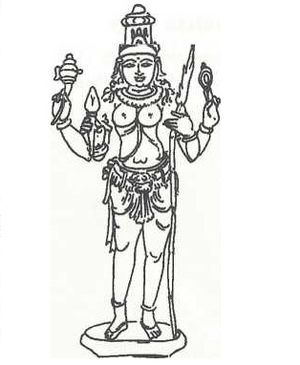Talk:Rājarājeśvari
By Swami Harshananda
Rājarājeśvari literally means ‘the mistress of even the king of kings’.
The goddess of the Kailāsanātha temple at Kāñcīpuram in Tamil Nadu has been called Rājarājeśvari. She has been named so probably because the temple had been built by the king Narasimha Varma, the Second. He lived in A.D. 695-722. He also assumed the title, ‘Rājarājeśvara,’ which means the king of kings’.
Rājarājeśvari as per Lalit Sahasranāma[edit]
Lalit Sahasranāma[1] uses this name as one of the epithets of Lalitā Tripurasundarī. In this scripture the name is interpreted as ‘one who is the mistress of even Brahmā, Viṣṇu, Maheśvara and Kubera’.
Rājarājeśvari as per Sodaśikalpa[edit]
She is described elaborately in the works like the Sodaśikalpa. The Bhairavi-tantra includes her among the Daśamahā-vidyās.[2] She is pictured as sitting on the left lap of Śiva on a throne with five deities called ‘pretas’. These five deities are:
- Brahmā
- Viṣṇu
- Rudra
- Īśvara
- Sadāśiva
Picturization of Rājarājeśvari[edit]
- She is extremely beautiful and bright.
- Her complexion is red.
- She has three eyes.
- The crescent moon illumines her crown.
- The sun and full-moon form her ear-rings.
- Her face is tranquil and pleasant.
- She is richly decorated with garlands and various kinds of jewels.
References[edit]
- The Concise Encyclopedia of Hinduism, Swami Harshananda, Ram Krishna Math, Bangalore


